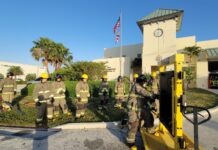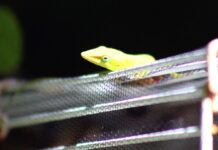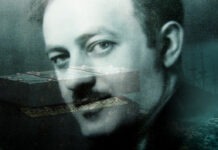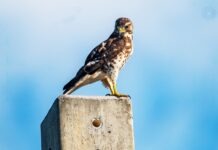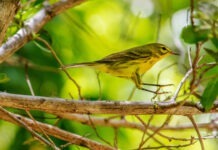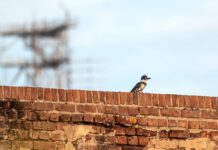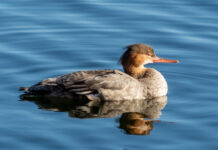We ran into our friend Pat Kennedy the other day while waiting for a table at the Hogfish. And because we were all just sitting there, passing the time, she asked me a couple of questions about birds, one of which was something along the lines of, why do some birds seem to have a fondness for certain power lines?
It’s a complicated question, and I gave her some kind of answer, though I can’t remember exactly what it was. I know it was probably too short and likely lacked detail because it was right then that they called our table. (This is not the time of year you want to risk losing a table in a busy restaurant.) But I’ve been thinking about the question over the last few days, so I figured I might try to answer it properly.
For one thing, for better or worse, power lines are part of the landscape now. Arguably they are habitat. I’m pretty sure 20 minutes after the first telegraph line was strung between two poles, a bird came in and landed on it. Most likely a pigeon or a dove. (For brevity, I’m going to use the term power line to encompass anything that stretches between utility poles – phone lines, electrical lines, data lines, etc.)
Birds are not purists. They will perch on nearly anything that doesn’t move – church steeples, rooflines, fence tops, parked cars, statues. I was going to say that almost any species will land on a wire, but then I thought about ducks. You never see ducks standing on power lines. Or any web-footed species for that matter. My favorites are white ibis, who have no real cause to stand on a wire, and are not very good at it, but will do it occasionally, wobbling like a tight-rope walker just before a tragedy.
Power lines are ubiquitous in the modern landscape. And they are generally safe for birds, unless they manage to somehow become the physical link that closes the circuit between the power line and the ground. It does happen on occasion, electrocuting the bird and knocking out the power for an indeterminate amount of time, as it did when Tom McGuane was speaking during the Key West Film Festival this year. Generally this happens to larger birds that can stand at the edge of a wire and have a wing that can span the distance of an insulator and make contact with the pole. Ospreys, turkey vultures, eagles.
The most general advantage of a perch like a power line is its height, reducing the threat from terrestrial predators – cats, raccoons, snakes. It also gives them more options for fleeing if an airborne predator, such as a hawk or falcon, comes after them. You generally see all the birds facing the same direction – into the wind. It makes it easier to land and requires less energy to get airborne.
Pigeons and doves are the most commonly seen on wires. In Key West and the more urbanized areas of the Keys, these are mostly mourning doves and Eurasian collared-doves. Sometimes they congregate in random areas. Sometimes they can be seen congregating in the same areas over repeated days, which usually means someone nearby is feeding them.
Flocking behavior has a few purposes. For one, birds can share information, such as the fact that one of them just spotted a feeder being filled. It is also a defense mechanism. A lone bird has a higher chance of getting caught by a predator. Groups often confuse predators by either scattering or flying around together in some orchestrated chaos. There’s also the fact that if you are in a group, and a predator is going to catch someone, there is a solid chance it won’t be you.
Mourning doves and Eurasian collared-doves will also occasionally play out their romances on wires, the males bowing and cooing as they approach, the females hopping away when they get near, until they eventually decide to fly off, or decide, heck, why not, and mate. You can also occasionally see young doves harassing their parents, who are sitting on the wire just to get a little peace and quiet.
You do see white-crowned pigeons up on the wires, but they tend to be in smaller familial groups instead of flocks.
In developed areas northern mockingbirds are often on wires, partly because it is the highest space around, but also because it allows their voice to carry farther when they are singing their fool heads off during mating season. Unlike other birds, they will face any which way, depending on where they are trying to project, or what they are trying to watch.
In the summer, gray kingbirds are regularly perched on wires, giving out their throaty whistle at regular, short intervals to attract a mate and mark their territory. Gray kingbirds are tyrant flycatchers, the tyrant part describing their demeanor, the flycatcher part describing how they feed. Besides the mating and singing, they also make sorties out into the open air to nab flying insects and gulp them down.
Neither American kestrels nor broad-winged hawks breed here, but they do winter here and are also seen on wires. Both species are perch hunters, though, and their motivations are different. They will sometimes perch for long periods without moving, waiting for something – a warbler or a mouse or a cardinal – to wander beneath them, so they can fall down upon them to attack.
If you drive up (or down) the Keys you might notice a lot of birds on the wires that run parallel to the bridges.
In the winter, one of the more common birds you will see, always alone, are belted kingfishers. They hang there for the same reason the broad-wings and the kestrels do – to hunt. But unlike the other two, kingfishers are splash feeders, diving down to feed on fish. They may not dive directly from the wire – usually they will fly out and hover for a few seconds – but from a wire they can monitor what’s going on in the water down below without expending much energy. They can also rest a bit while digesting.
You also see a lot of double-crested cormorants on the wires – an exception to my previously stated webbed-foot rule – but they are just usually trying to get out of the water for a while.
The only things that rival cormorants for their numbers on the wires next to bridges are the flocks of rock pigeons. They are together because, like the mourning doves and Eurasian collared-doves, they tend to be colonial birds. They are next to the bridges because they nest underneath them.
There are probably more things to say about birds on wires in the Keys, but damn, they just called our table. Gotta go.




